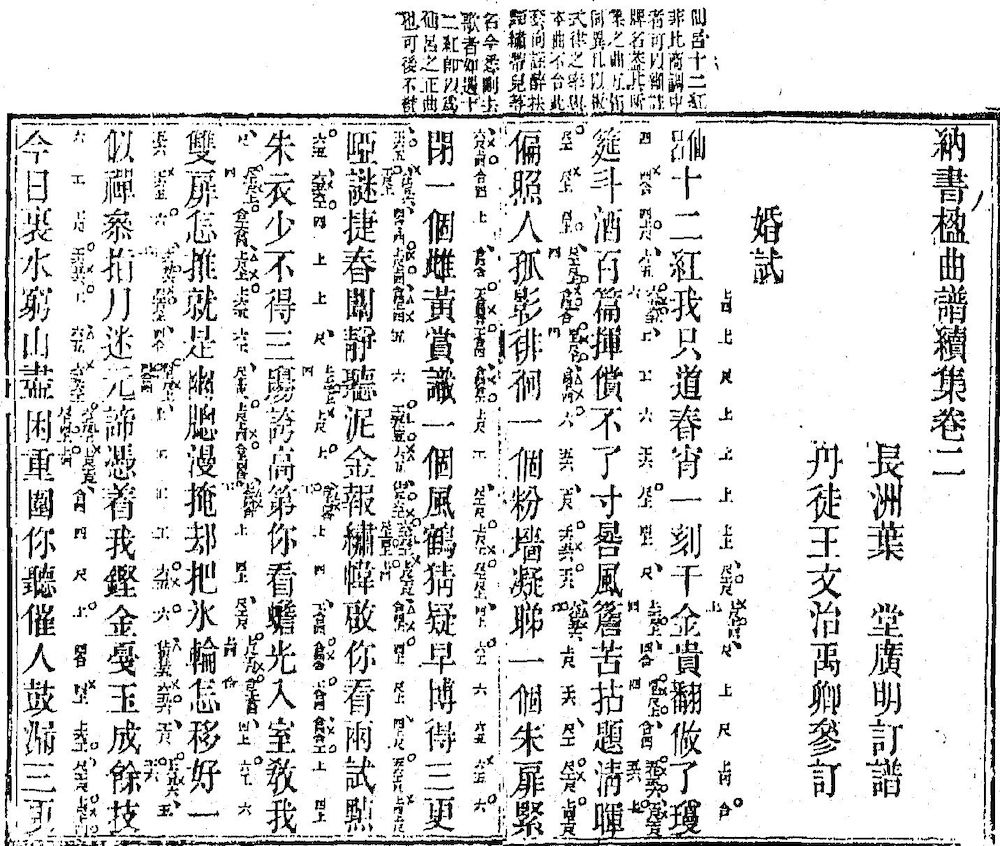Nashuyin qupu 納書楹曲譜 "Scores of arias from the Studio of Book Acquisition" is a collection of music scores compiled during the Qing period 清 (1644-1911) by the music master Ye Tang 葉堂 (1736-1795), courtesy name Guangming 廣明 or Guangping 廣平, style Huaiting 懷庭. The collection was finished in 1792 and includes a total of 14 juan, with a main collection (Zhengji 正集) of 4 juan, a subsequent collection (Xuji 續集) of 4 juan, an "outer" collection (Waiji 外集) of 2 juan, and a supplement (Buyi 補遺) of 4 juan. It is a critical edition of theatrical and stand-alone tunes that were popular during the Qianlong reign-period 乾隆 (1736-1796), like Yongdie 詠蝶, Yonghua 詠花 or Liufei 柳飛. It also includes many older artistic tunes of various modes (zhugongdiao 諸宮調) from the collection Tianbao yishi 天寶遺事 (like the suite Majian Yang fei 馬踐楊妃), or widely played tunes like Zui Yangfei 醉楊妃, Zhaojun 昭君, Lulin 蘆林, Sifan 思凡 or Huagu 花鼓. The collection includes a total of 360 music pieces.
 |
Tablature for the tune Hunshi 婚試, played in the key Xianlü 仙呂. While the text is held in large characters, the signs for the musical instruments are printed very small. Above, notes by Wang Wenzhi 王文治 can be seen. |
Ye Tang was very interested in creating correct standard scores for famous airs like those in Tang Xianzu's 湯顯祖 (1550-1616) play Mudanding 牡丹亭 (also called Huanhunji 還魂記), or such from the plays Handanji 邯鄲記, Nankeji 南柯記 and Zichaiji 紫釵記 (these four plays are known as Yumingtang simeng 玉茗堂四夢 "Four dreams of the Hall of Jade Tea"). He therefore compiled the scores for these four southern plays, with a total length of 22 juan, and did the same for the northern play Xixiangji 西廂記 by Wang Shifu 王實甫 (c. 1260- c. 1336) from the Yuan period 元 (1279-1368), entitled Nashuying Xixiangji quanpu 納書楹西廂記全譜, with a length of 2 juan, and printed in 1795.
Unfortunately enough, his books do not include any plain-text passages (kebai 科白), and do not add symbols for time and rhythmic shape (biaotou 標頭, moyan 末眼) to the score, so that they are not helpful to prepare performances of these theatre plays.